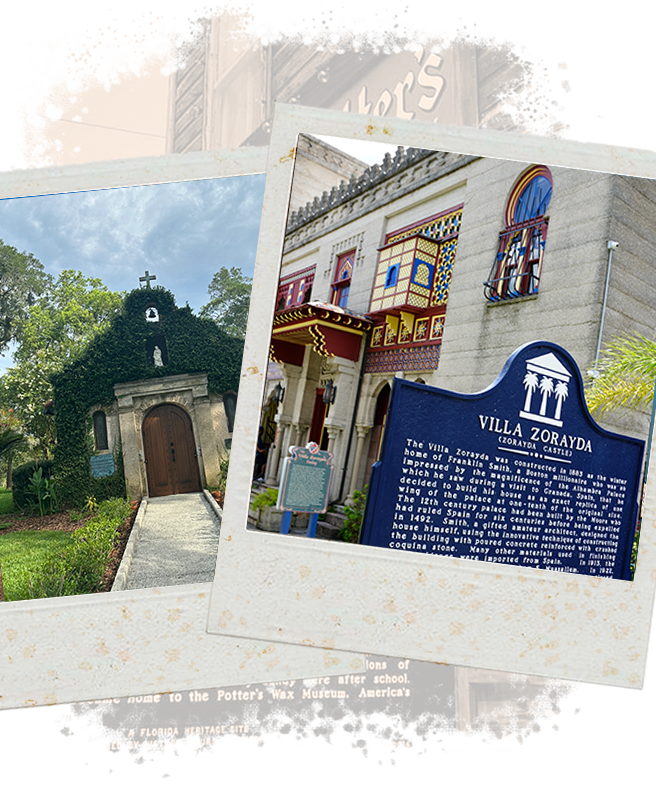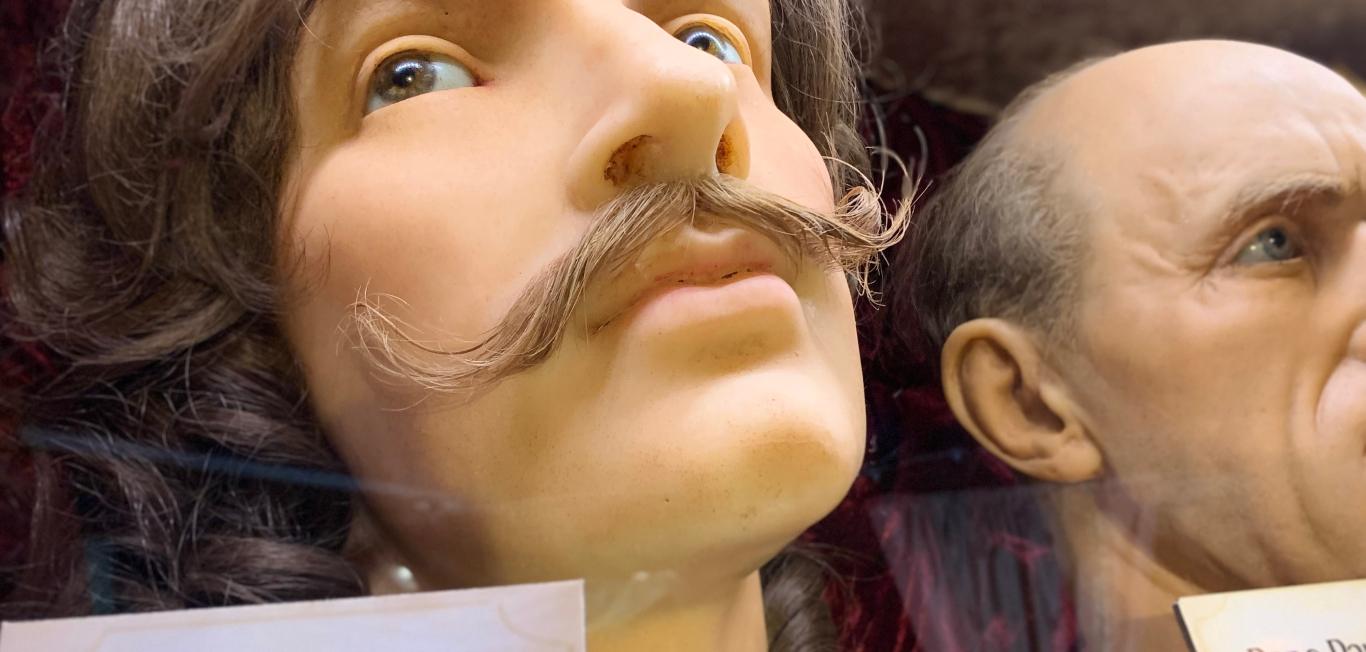Must-Visit
St. Augustine Museums
St. Augustine, steeped in history and culture, is home to a wealth of captivating museums and awe-inspiring churches that you ought to include in your vacation itinerary. These magnificent landmarks, each with a story to tell, offer insightful glimpses into the city’s rich past and deep-rooted traditions. Whether you’re a history buff seeking to unravel the intriguing tales of the oldest city in the U.S. or a spiritual soul yearning for tranquility and enlightenment, St. Augustine’s museums and churches offer a remarkable journey that caters to diverse interests and promises an enriching and unforgettable experience.
Potter’s Wax Museum
History
Potter’s Wax Museum in St. Augustine’s Historic District is an essential cornerstone of the city’s cultural legacy. Opened in 1948 by George Potter, it stands as America’s first and oldest wax museum, housing over 160 wax figures of historical and contemporary personages. From royal families and U.S. presidents to famous musicians and fictional characters, the museum offers a unique lens into history and culture.
Exhibits To See
Today’s visit to the Potter’s Wax Museum in St. Augustine, the first and oldest wax museum in America, remains as fascinating as when it first opened. It’s an electrifying journey through time where you encounter lifelike wax figures of cultural icons. Rub shoulders with U.S. presidents, such as Lincoln and Washington, or historical figures like Benjamin Franklin, Cleopatra, and Ponce de León. The allure of standing next to sports legend Michael Jordan or meeting Henry VIII and his wives is irresistible. With the continuous addition of new figures and interactive elements, each visit becomes a unique, engaging experience.
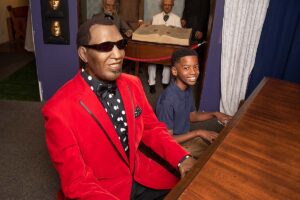
History of the
St. Augustine Lighthouse & Maritime Museum
Perched 165 feet above sea level on Anastasia Island, the St. Augustine Lighthouse & Maritime Museum stands as a testament to the city’s rich maritime legacy. Originally constructed as a wooden watchtower by Spanish settlers in the late 1500s, the iconic structures now offer visitors a captivating journey through seafaring history. Adjacent to the lighthouse, the historic Keeper’s House, built in 1876, once provided sanctuary for the families of vigilant lighthouse keepers. Today, it serves as the heart of the museum, offering immersive insights into the lives of those who tended to this vital maritime beacon. From its breathtaking views to its enlightening exhibits, the St. Augustine Lighthouse & Maritime Museum promises an unforgettable experience for all who venture to its hallowed grounds.
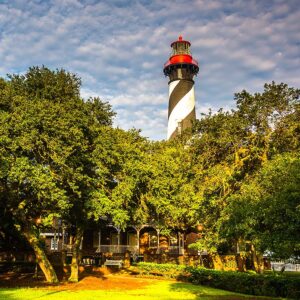
Things To Do at the St. Augustine Lighthouse & Maritime Museum
At the St. Augustine Lighthouse & Maritime Museum, visitors can climb the 219 steps to the top for a panoramic view of the city, explore shipwreck artifacts, and learn about the lighthouse keepers through interactive exhibits. The combination of breathtaking views, intriguing history, and family-friendly activities make them an unmissable highlight for any St. Augustine vacation. The museum’s commitment to preserving and sharing St. Augustine’s maritime history creates an educational and enriching experience that captivates visitors of all ages.
History of the
Governor’s House Cultural Center and Museum
Nestled in the heart of Downtown Historic St. Augustine, the Governor’s House Cultural Center and Museum stands as a testament to centuries of administrative and political life. Dating back to 1598, when Governor Gonzalo Méndez de Canzo established his residence on this site, the Governor’s House has witnessed a myriad of governmental functions. From serving as a residence for governors to housing various government offices, and even functioning as a post office, this location has played a pivotal role in the city’s governance throughout its storied past. Recognized for its historical significance, the Governor’s House was added to the National Register of Historic Places on January 7, 2014.
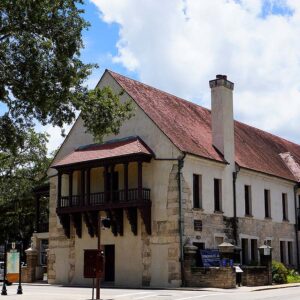
Things To Do at the Governor’s House Cultural Center and Museum
Today, the Governor’s House Cultural Center and Museum offers visitors an immersive journey through St. Augustine’s rich history. Step inside to explore exhibits tracing the building’s evolution from its inception to the present day. The newly updated lobby serves as a dynamic space for rotating exhibits, showcasing captivating displays that bring the past to life. Beyond its role as a museum, the Governor’s House serves as a versatile event space. The Sala de Montiano Room, a popular venue for weddings and celebrations, along with the expansive courtyard, provides an ideal setting for gatherings of up to 120 people. From educational workshops and seminars to cultural celebrations and historical reenactments, the Governor’s House Cultural Center and Museum offers a diverse array of experiences that enrich community knowledge and celebrate the city’s vibrant heritage.
Villa Zorayda Museum History
Of all the St. Augustine museums, Villa Zorayda Museum holds a special place, recognized by the U.S. National Register of Historic Places for its distinctive collection of American antiquities. Visitors marvel at the historical hand-carved tropical hardwood furniture and the intricate interior craftsmanship. It’s not just the flooring and ornate windows that tell the tale of this historic site but every piece within its walls, affirming Villa Zorayda’s status as a cultural cornerstone of America’s oldest city.
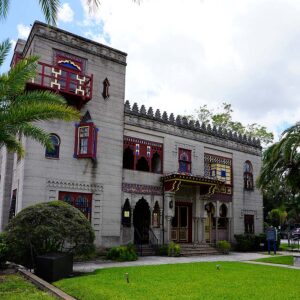
Things To Do at the Villa Zorayda Museum
Visitors to Villa Zorayda Museum, one of the premier St. Augustine museums, are enthralled by the Grand Alhambra Hall, renowned for its detailed architecture that echoes a Moorish palace. A highlight is the “Cut Glass” exhibit, showcasing exquisite American Brilliant Period glass. The museum also offers an audio tour featuring the history of each room for a more immersive experience.
At Villa Zorayda Museum, a St. Augustine museum with storied allure, visitors should not miss the “Court of Lions” exhibit, a tribute to the original Alhambra palace’s courtyard. Self-guided audio tours, available in English, Spanish, and French, enrich the experience, detailing 138 years of the villa’s vibrant history and its 98% original art and antique collection. The tours encourage guests to explore at their own pace.
History of the
Old Jail Museum
The Old Jail Museum in St. Augustine, built by Henry Flagler in 1891, offers an unforgettable glimpse into the city’s intriguing criminal past. It held notorious criminals until 1953 and executed eight men on its gallows. Today, this National Registry of Historic Places member stands as an absorbing teacher of correctional history. Its captivating stories of justice and capital punishment make it an essential destination for vacationers in search of an authentic historical experience.
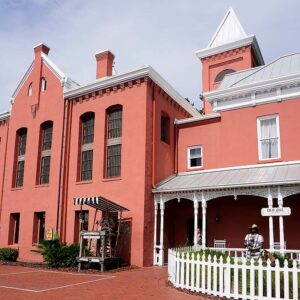
Things To Do at the Old Jail Museum
At the Old Jail Museum, a key attraction within the St. Augustine museum community, visitors can embark on a journey through time with an informative and engaging guided tour. This family-friendly expedition transports guests through the prisoners’ cells, which hold the echoes of inmates’ pasts. Venturing through the foreboding maximum security area reveals a piece of penal history that is as fascinating as it is sobering. The tour culminates with a chilling view of the gallows, a reminder of the consequences of crime in bygone eras. Not to be overlooked, the sheriff’s quarters offer a glimpse into how the other half lived, literally a world away from the incarcerated. Alongside these captivating sights, the museum showcases a variety of weapons and artifacts, each contributing to the palpable sense of history that makes the Old Jail Museum a must-see among the St. Augustine museums.
History of the
Pirate & Treasure Museum
Among the St. Augustine museums, the Pirate & Treasure Museum offers an enticing excursion into the golden age of piracy. Housing one of the largest assemblages of authentic pirate artifacts in the world, it is a treasure trove for history enthusiasts. Notable pieces include Captain Thomas Tew’s 17th-century treasure chest and the journal of Captain Kidd’s final voyage in 1699. First established by Pat Croce in St. Augustine in 2005, this museum brimming with artifacts, some over three centuries old, found its new home in St. Augustine in 2010, standing opposite the historic Castillo de San Marcos.
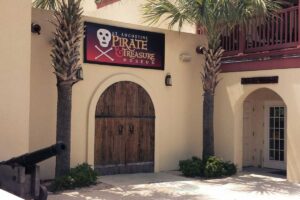
Things To Do at the Pirate & Treasure Museum
The Pirate & Treasure Museum in St. Augustine is a treasure trove of pirate lore, boasting an 800-piece collection. Highlights include the world’s oldest known treasure chest, one of the only three remaining original Jolly Roger flags, Blackbeard’s blunderbuss, and gold from his ship, the Queen Anne’s Revenge. Visitors can immerse themselves in a 17th-century buccaneer’s life by hoisting flags, firing a cannon, and walking the cobblestone streets of Port Royal. Explore a pirate ship, view an award-winning Disney documentary on Blackbeard, see the world’s oldest wanted poster, and marvel at a centuries-old gold bar. An exhibit celebrates Hollywood’s favorite pirates, and the outdoor deck offers stunning views of Matanzas Bay.
A Guide to the
Historic Churches of St. Augustine
Cathedral Basilica History
Among the historic St. Augustine churches, the Cathedral Basilica stands out not just for its striking architecture but for its deep-rooted history. The cathedral’s original structure dates back to the 1700s. The edifice presents a fusion of Spanish mission and neoclassical styles, reflective of the area’s diverse heritage. The Cathedral Basilica gained recognition as a U.S. National Historic Landmark, a testament to its significance in the fabric of American history. Its congregation is notably the oldest, established in 1565. In 1997, Pope John Paul II designated it as a Cathedral Basilica, and during his 1999 visit, bestowed further honor upon this sacred site, which is distinguished by the symbolic tintinnabulum (bell) and ombrellino (umbrella) at the High Altar.
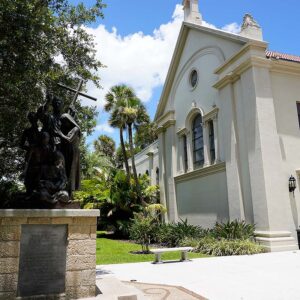
Things To Do at the Cathedral Basilica
Explore the history of the Cathedral Basilica in St Augustine by taking a guided tour of the public and not-so-public locations within the Cathedral Basilica of Saint Augustine. Tour stops include the choir loft, sacristy, confessional, baptistery, chapel and more. Delve deeper into the symbolism of the edifice and its past in the informative tours. Learn the stories behind the stained-glass windows, the Stations of the Cross, the bishop’s coat of arms in the rafters, the murals, and the three burials within the church. Don’t miss out on the opportunity to purchase religious items at the Cathedral gift shop.
History of the
Ancient City Baptist Church
Established on January 20, 1887, with just 18 charter members, the Ancient City Baptist Church has stood as a pillar of faith and community in St. Augustine. Its rich history intertwines with the generosity of Henry Flagler, who in 1894 offered the church a parcel of land valued at $5,000, free of charge, for construction. However, Flagler’s offer came with specific conditions: the property could not be mortgaged, no bell could adorn the bell tower and construction must conclude within two years. Rising to the challenge, the congregation completed the magnificent Romanesque Revival-style church in April 1895. Adorned with a distinctive cone-shaped turret atop a three-story tower and featuring oval stained-glass windows, the tan brick sanctuary was dedicated on February 2, 1896. Over the years, the church has undergone renovations, including a significant restoration effort in 2003 led by retired glass craftsman Dee Tarrant, ensuring the preservation of its original stained-glass windows and architectural integrity.
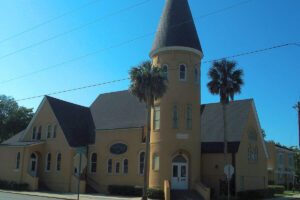
Things To Do at the Ancient City Baptist Church
Explore the Ancient City Baptist Church with a visit to the history room, a repository of early memorabilia and archived insights. A host will welcome you, answer any questions, and point you in the right direction for you to explore at your own pace. This combination of exploration and enlightenment offers a unique perspective into this historical landmark of St. Augustine.
History of
Grace United Methodist Church
Constructed in 1887 and donated to the people of St. Augustine, Florida, by Henry Morrison Flagler, the Grace United Methodist Church stands as an influential part of St. Augustine’s rich history and heritage of St. Augustine churches. This architectural gem, located at 8 Carrera Street, holds a significant place in the city’s narrative and was rightfully listed on the National Register of Historic Places in 1979. Notably, it became a symbol of unity when First United Methodist Church and Hope United Methodist Church, established in 1858 and 1988 respectively, merged to form Grace United Methodist in 1994, solidifying its role as a unifying force within the community.
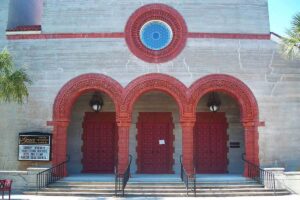
Things To Do at Grace United Methodist Church
Experience the architectural splendor of Grace United Methodist Church in St. Augustine. Join a spiritually uplifting worship service and appreciate the serene environment. Key attractions include stained-glass windows and original pews, reflecting the church’s rich history. This visit provides not only a historical perspective but also a chance to engage in meaningful spiritual reflection.
History of the
St. Photios Greek Shrine
The St. Photios Greek Orthodox National Shrine, on historic St. George Street, pays homage to America’s first Greek settlement. As part of the Greek Orthodox Archdiocese of America, this shrine, constructed in 1749, commemorates the inaugural Greek immigrants to St. Augustine, Florida. The profound historical resonance and spiritual importance of the St. Photios Greek Orthodox National Shrine make it a compelling destination for those eager to immerse themselves in St. Augustine’s cultural legacy.
Things To Do at the St. Photios Greek Shrine
At St. Photios Greek Orthodox National Shrine, visitors can marvel at the Byzantine-style murals, adorned with 22-karat gold leaf, which reflect the apostles and saints of the Christian church. Special exhibits illuminate the narrative of the first Greek colony in the New World, featuring various artifacts, photographs, and historical documents. You can visit the Shrine Chapel and museum and take a stroll through the gift shop on-site that sells religious items, Greek food goods, and jewelry.
Mission Nombre de Dios History
The Mission Nombre de Dios represents a pivotal moment in St. Augustine’s history and the birthplace of Christianity in America. Home to the Great Cross, erected to honor the 400th anniversary of the first Catholic Mass of the parish, the mission exudes a profound spiritual aura. The museum at the site presents a captivating narrative of St. Augustine’s founding and Christianity’s propagation, making it an exemplary destination for vacationers keen on history and spirituality.
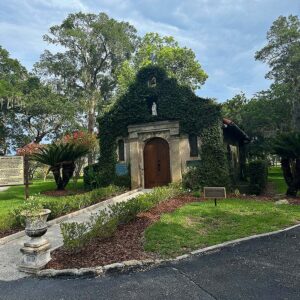
Things To Do at Mission Nombre de Dios
At Mission Nombre de Dios, explore the museum with exhibits and artifacts, including the original casket of Menendez from 1574. The chapel dedicated to Our Lady of La Leche houses a beautifully carved statue of Mary and baby Jesus. Discover archaeological excavations and a historic cemetery on the grounds. This unique blend of history and spirituality makes it an important and enriching visit.
FAQs
What’s the oldest church in St. Augustine, Florida?
The oldest church in St. Augustine, Florida, is the Cathedral Basilica of St. Augustine, which traces its origins back to the Spanish settlers who landed in 1565. The current structure, completed in the 1700s, stands as a testament to St. Augustine’s rich history and cultural diversity. A National Historic Landmark, it continues to serve as an active parish, a pilgrimage site, and a beacon of historical and architectural interest for visitors.
Who built Mission Nombre de Dios?
Mission Nombre de Dios was built by Spanish settlers who arrived in the New World in 1565. They established the mission as part of their efforts to spread Christianity in the area now known as St. Augustine, Florida. The Great Cross, which stands on the mission grounds, was erected to commemorate the 400th anniversary of the first Catholic Mass held there by the parish.
Which is one of the most famous museums?
One of the most famous museums in St. Augustine, Florida, is the museum at Mission Nombre de Dios. It provides a captivating narrative of St. Augustine’s founding and the propagation of Christianity from 1565 to the present day. In addition to its historical exhibits, the museum also houses artifacts, including the original casket of Menendez from 1574. The site is renowned for its blend of history and spirituality, making it a significant and enriching destination for visitors.
How long does it take to go through the St. Augustine Pirate & Treasure Museum?
The duration of a visit to the St. Augustine Pirate & Treasure Museum can vary greatly depending on the visitor’s interest in pirate history. However, most guests spend between one and two hours exploring the exhibits. This allows sufficient time to read the informative displays, interact with the hands-on exhibits, and fully experience the treasure-hunting adventure. Remember, the museum is self-guided, so you can explore at your own pace and delve into the rich history of piracy.
